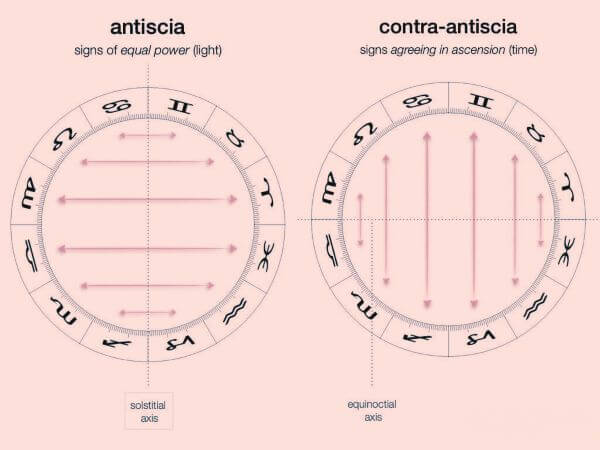Antiscias And Shadows Of The Planets
Antiscia And Shadows Of The Planets
A Practical Guide to Jungian Psychology
1. Introduction
Antiscia are points of planetary reflection across the Cancer-Capricorn axis in astrology. Each planet has an antiscia which is located symmetrically in relation to 0° Cancer-Capricorn. For example, the Sun at 10° Aries has an antithesis at 20° Cancer.
Antiscia are often called “shadow planets” because they indicate unsanctified potentials , latent abilities and parts of the personality that manifest indirectly. Understanding the antiscia allows the identification of internal patterns and hidden resources , which is in line with Jung’s psychology of the unconscious.
Antiscia and Contra-Antiscia in astrology
1. Antiscia
Antiscia are mirror points of the planets in relation to the X-axis or the axis of the winter solstice (0° Cancer – 0° Capricorn) .
Planets in antiscia positions have a hidden connection and reflect a similar energy or theme, even if they are not in classical aspect by degree.
For example, a planet at 10° Cancer has an antiscia at 20° Taurus (mirroring around the 0° Cancer–0° Capricorn axis).
This connection often shows the inner or hidden connection of the planets, as well as psychological or karmic correlations.
2. Contra-Antiscia
Contra-Antiscia are mirror points of the planets in relation to the axis 0° Leo – 0° Aquarius , i.e. the opposite axis. This technique indicates opposite-mirror connections and helps to see the contrasting or balancing energies between the planets. While antiscia emphasizes harmony and subtle connection, contra-antiscia often indicates tension or internal polarization, but also the possibility of integrating opposites.
3. Application in interpretation
Planets connected through antiscia can indicate hidden talents, inner harmony or karmic connections. Planets connected via contra-antiscia can indicate internal conflicts, contrasting tendencies, or the potential to balance opposites.
These techniques are especially used in classical astrology and for finer psychological analyzes of natal and transit charts.
2. Shadows of the planets
In astrology, the shadow of the planet indicates the parts of the planet’s energy that a person does not use consciously. Shadows are not negative by definition; they represent the potential for development or integration.
Examples of shadows by planets:
Sun: repressed personal will, unrecognized identity.
Moon: raw emotions, repressed need for security.
Mercury: unexpressed intellectual potential, blocked communication.
Venus: unsanctified love and creativity, problems in relationships.
Mars: repressed energy, passive-aggressive behavior.
Jupiter: limited growth, skepticism towards learning and expansion.
Saturn: fear of responsibility, self-imposed limitations.
Uranus: rejection of change, unconscious fear of freedom.
Neptune: suppressed intuition, escape from reality.
Pluto: repressed power and transformative energy, destructive impulses.
Jungian perspective
Carl Gustav Jung defined the shadow as a part of the psyche that the individual does not recognize or rejects. The shadow is part of the unconscious, but its integration is key to psychological development. Antiscia in the horoscope can be interpreted as indicators of unconscious aspects of the psyche . Antiscia analysis makes it possible to:
1. Recognize latent potentials.
2. Identify patterns that repeat throughout life.
3. Integrate repressed aspects of personality into conscious practice.
4. Function of antiscia
Antiscia provide information about the hidden or latent energies of the planets and their shadows, and are used for:
1. Introspective work and self-observation,
2. Identification of emotional and mental patterns,
3. Development of personal potentials that have not been realized until now.
5. Practical examples of antiscium by planets and Jung’s work
Sun
Antiscium: hidden potential of self-confidence, leadership and creativity.
Shadow: low self-esteem, suppressed identity. Antiscium
Moon: latent emotional intuition and need for security. Shadow: repressed emotions, reactivity.
Mercury
Antiscium: hidden intellectual capacity, intuitive thinking.
Shadow: repressed thought, inability to express clearly.
Venus
Antiscium : unsanctified capacity for love, artistic expression and relationship.
Shadow : insecurity in love, unrecognized value of one’s own person.
Mars
Antiscium: latent energy, capacity for action and initiative.
Shadow: repressed aggression or passive-aggressive impulses.
Jupiter
Antiscium: hidden ability to grow, learn and broaden horizons.
Shadow: skepticism, limiting one’s own development.
Practical work : writing down situations where you resist new experiences, introspective recognition of limiting patterns, conscious planning of learning new skills.
Saturn
Antiscium: latent discipline, patience and stability.
Shadow: fear of responsibility, self-imposed limitations.
Uranus
Antiscium: latent innovation and freedom.
Shadow: rejection of change, fear of release.
Neptune
Antiscium: hidden intuition and creativity.
Shadow: escape from reality, confusion.
Pluto
Antiscium: latent transformative power.
Shadow: repressed control, destructive impulses
6. Methods of introspective work with
antiscia Antiscia diary: recording events and reactions associated with the planet in antiscia position.
Reflexive analysis: asking the question “When did I suppress this energy?” or “How can I consciously use this potential power?”.
Practical application: conscious inclusion of latent abilities in everyday tasks.
Meditation and introspective contemplation : focusing on the inner impulses associated with the antiscia planet.
Pattern Tracking: Identifying recurring patterns that indicate shadow activation.
Conclusion
Antiscia and shadow planets represent practical tools for introspective work and personal development . Through the recognition of latent energies and unconscious patterns, a person can:
better understand his emotional and intellectual reactions, integrate suppressed aspects of personality, develop a greater degree of awareness and psychological maturity.

